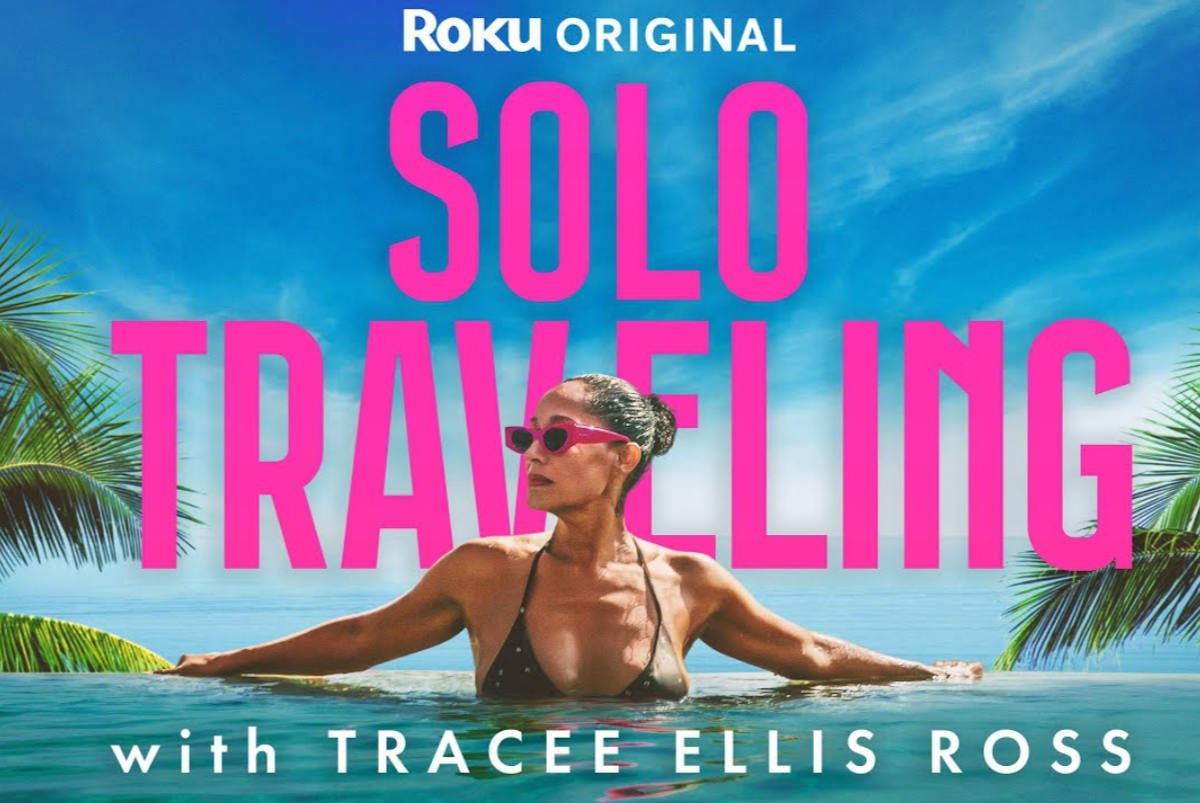Tracee Ellis Ross attends the Travel + Leisure World’s Best Awards 2025 on July 16, 2025 in New York City
Jamie McCarthy/Getty Images for Travel + Leisure

This story is part of The New Era of Work Travel, a collaboration between the editors of Condé Nast Traveler and WIRED to help you navigate the perks and pitfalls of the modern business trip.
Business travelers are made, not born. And almost everyone who travels frequently for work can list off at least a few things they wish they’d known when they first got into the game. It’s not all obvious—like the importance of committing to a points and miles program early on; these programs literally exist because of you, dear business travelers—and some is nuanced and only learnable with time, like finding a hotel that feels like home and lets you leave a suit in the closet.
To gather the rules of the road, we chatted with highly-seasoned business travelers about what they wish someone wiser had told them at the start of it all. These sources come from many lines of work and walks of life—museum directors who know which gala dresses are easiest to pack, private equity and corporate law guys who prefer boutique hotels, young communications specialists who’ve learned to find the romance in everything, and so on. (A number of people we interviewed asked to use a pseudonym—this is hard hitting stuff!—which you’ll see reflected below.)
Read on for their tips and tricks of successful business travel.
It’s exciting when work sends you to far-flung places that you’ve always wanted to visit—but don’t let the novelty trick you into thinking you’re getting a vacation. “My first couple of work trips took me to Europe, which was very exciting for a fresh out of college twenty-something,” says Zelda, a communications specialist for the International Council on Clean Transportation. “Being a young person who couldn’t afford a transatlantic flight and three-star hotel rooms on my dime, I immediately felt the need to get the most out of the experience. That pressure, combined with the actual work I needed to do on the trip, was a recipe for burnout.”
You have to do your work, and do it well, in order to continue being sent on work trips. And you’re likely going to be exhausted thanks to the itinerary, networking, and drinking, all of which are reliable elements of her business trips. Make sure work, and then rest, are your priority, before finding time for sightseeing and moments of leisure in your after-hours. To that end…
Alex Green
“I have given up trying to get the most out of the hours directly around my required work, because I really need those times to rest,” Zelda says. “A fancy hotel room should be enjoyed to its fullest. A bathrobe? Pool? Spa? Even just sleeping or watching TV in freshly changed sheets. Charli XCX says it best: Everything is romantic.” Give yourself a break, especially if you’re going to be on the clock for longer hours than when you’re at home.
Frequent business travelers are the reason points, miles, and loyalty programs exist, and to not take advantage of them only hurts you. This may feel less true in recent years, as it’s become notoriously difficult to earn status at one single airline. But most agree that the following remains true: The moment it becomes clear that travel is going to be a big part of your job, choose an airline alliance and lock into the loyalty program. When Lucie, now a partner at a major management consulting company based in New York, first began traveling a lot for work, she booked whichever airline had the most convenient departure time. “I admittedly was not in that game as early as I should have been, and then I realized the money that I was leaving on the table.” Now, she has “insane” Delta status that makes her personal travel basically free, she says.
Delta, among the sources in this story, is far and away the favorite, with United not-so-close behind. But if you’re wondering which airline has the best rewards program, Paul, a corporate lawyer, keeps an eye on the situation and says it’s not always so simple: “Some airlines are clearly better than others, and it’s fluid. Right now, I’ve been getting way better deals from American Airlines than United or Delta.” Which brings up another point: Even if you’re loyal to one airline, enroll with everyone and collect points wherever you can.
Give yourself the luxury of time and book your flight to arrive the day before you have to get down to business. You don’t have to take that red eye. Rahul Khosla of Heady.io says, “It makes the trip longer, yes, but it’s much easier to keep your routine this way and feel more sharp for the meeting [or work event] itself. [Otherwise] eating gets weird, sleep gets disrupted, and you probably won’t have time to go to the gym because you’ll be too tired. One more perk of flying out early—I’m not as stressed if delays happen, because I know I’m not cutting it super close.”
“I don’t know if you can call yourself a savvy business traveler without them,” says Paul of programs like Clear and TSA PreCheck that help expedite travelers’ journeys through airport security. The lines at most airports are long and only getting longer, and the lounge is sitting on the other side waiting for you. Divide the annual fee by the amount of times you traveled last year and see how little it will really cost you. (And, if you’ve got a great credit card, the fee may even be waived.)
Regardless of your status, it’s unlikely, according to my sources, that you’ll get upgraded out of basic economy into business. But premium? That’s when they see you. That’s when they might move you up. And if they don’t, you’re already in premium. It’s difficult to regret.
That second part is key. You have nothing to lose when you request an upgrade, whether that’s from the aforementioned premium into business, or from a standard hotel room to an executive suite. But it’s also true that you’ll catch more flies with honey: Gate agents and hotel reception are the keepers of the keys, they’ve seen it all, and they get to be arbitrary. If you approach them with even a shred of entitlement, they’ll clock it and you’ll lose out. Humble yourself, business traveler. “I’ve gotten some outrageous upgrades just from asking nicely,” one private equity man tells me.
Alex Green
While there’s a clean split between checking bags and carrying them on, in no space were these sources more unanimous than in their exultation of packing cubes. Nearly everybody that I spoke to brought them up organically, including Carl Friedrik, co-founder of Niklas Oppermann (and not just because his company sells them). “I do it by type of clothing,” he says, “and then you can use one or two for dirty laundry as the trip progresses. I’m a convert to packing cubes.”
Jet lag is the bane of the business traveler’s existence. Some cases are worse than others, but it’s always looming to some degree in the shadow of those who change time zones. Tips on how to best cope vary, but there’s a consensus around one particular strategy: adopting the time zone of your destination the moment you board your flight. “So, if you’re landing at 9 in the morning wherever you’re going, you have to act like it’s night on the plane even if it isn’t where you’re leaving from,” DEI executive Yentil Rawlinson of Sherwin-Williams tells me. “It’s a necessary evil and the only thing I’ve tried that works.” Some travelers even manually reset their phone to the time zone of their destination upon boarding the plane, to begin adjusting. However you can trick yourself, trust your body will follow.
I know we said that loyalty is everything, and for airlines it absolutely is. It is similarly difficult to deny the power of accruing those big brand points at hotels, which many travelers use to cash in on a luxury stay (ideally, on their personal travels in the future). But while you’re untethered and unmoored, go for something that feels like a version of home to you. “I generally prefer staying in independent hotels because they get to know you over repeat visits,” says Paul. “If you stay at a big brand, it’s hard—the concierges at these places are not as good as they used to be. In London, I used to stay at the Chiltern before it burned down. I’ve gotten on a flight, texted them that I forgot my pajamas, and guess what’s waiting for me pressed on arrival? High thread count cotton pajamas.” He would even leave a suit and tie there. While many such properties aren’t part of loyalty programs, World of Hyatt brought Mr. and Mrs. Smith, and the boutique properties available on their booking platform, under the Hyatt umbrella this year—so it’s becoming possible to earn points while staying boutique.
One of the most valuable lessons a former CEO taught Rawlinson was to hand your clothes over to the hotel pressing service upon arrival. “If you’re going for four or five days, keep one outfit and have the rest pressed,” she says. “And at the end, have them all dry cleaned so you’re only packing clean clothes.”
Mariet Westerman, director of the Guggenheim, is wearing one of her favorite suits for travel when she speaks to me. It’s from Theory. “They make these really lightweight clothes that you almost never have to dry clean.” When things get more formal, a gala for example, she trusts one brand: Missoni. “Missoni just does not crinkle—they have the crinkles they need, and that’s it.” For the boys, most observe that suits have been phased out of their packing list entirely. They instead bring black or navy pants, and black or navy shirts.
Alex Green
You need one pair of shoes that can do it all. Multiple people I speak to swear by the collaboration sneaker between New Balance and Aimé Leon Dore for this exact multi-purposing.
Bring nice gym clothes, people—odds are, your boss is going to be at the treadmill next to yours. “You do not want to show up in ratty gym shorts,” Bianca Consunji of Netflix tells me, “I speak from experience. You also want to bring headphones, to signal that this is time that you want for yourself.”
Whether they’re fellow convention-goers, or coworkers from the office abroad, the people who live in the destination you are traveling to harbor the best recommendations for low-key, off-the-beaten path things to do once the working day is done. Westermann from Guggenheim was in Hong Kong with a locally-based colleague, and they had a lot of time to spend together. He told her: “Let’s go walking in the warehouse district and you’ll see a different demographic.” They walked and took the metro together, as was his preference, rather than hailing cabs; this showed her the city anew.

The global solo travel market, valued at $482.5 billion in 2024, is projected to surge to $1.07 trillion by 2030, growing at a blistering 14.3% CAGR. This explosion is not merely a post-pandemic rebound but a seismic shift in how people engage with the world. Solo travel is evolving into a $1 trillion wellness-driven consumer revolution, fueled by Gen Z and Millennials prioritizing self-discovery, digital nomadism, and hyper-personalized experiences. For investors, this trend offers a golden opportunity to capitalize on three pillars: lifestyle brands, experiential tech, and emotional wellness platforms.
The solo travel boom is underpinned by three key forces:
1. Post-Pandemic Behavioral Shifts: The pandemic normalized solitude, with 76% of Millennials and Gen Z planning solo trips in 2025. Solo travel is now seen as a path to self-care, mental health, and meaningful social connections.
2. Digital Nomadism: Hybrid work models have turned travel into a lifestyle. Digital nomads, who often stay in destinations for months, are reshaping demand for flexible accommodations, co-working spaces, and wellness-focused stays.
3. Experiential Consumption: Consumers increasingly value experiences over material goods. Solo travelers seek transformative journeys—wellness retreats, cultural immersion, and immersive tech-enhanced adventures.
Hotels and resorts are redefining their offerings to cater to solo travelers. Hilton and The Oberoi Beach Resort in Mauritius, for instance, have introduced “MeMooning” and “Touching Senses” programs, respectively. These include flexible seating, personalized dining, and wellness activities like stargazing and painting.
Investors should target brands that:
– Prioritize Solo-Friendly Design: Look for properties with private spaces, co-working areas, and safety-focused amenities (e.g., women-only tours).
– Leverage Niche Demographics: Women now account for most solo bookings, driven by empowerment and safety innovations. Brands like A&O Hostels in Europe, which blend work-friendly infrastructure with social hubs, are prime candidates.
– Integrate Wellness: The Oberoi’s $200-per-night “Touching Senses” package, which includes cultural workshops and mindfulness sessions, reflects a growing demand for purpose-driven stays.
Technology is the backbone of the solo travel renaissance. AI-powered platforms like Booking.com and Expedia are now offering hyper-personalized itineraries, real-time safety alerts, and dynamic pricing models. Startups are emerging to fill gaps in solo-specific services:
– AI Itinerary Planners: Tools like Much Better Adventures use machine learning to curate adventure-based trips, fostering “type two fun” (shared challenges that build connections).
– Sustainability Platforms: Apps like GreenGo integrate carbon calculators and eco-certified accommodations, appealing to eco-conscious solo travelers.
– AR/VR Integration: Virtual reality tools are enhancing pre-trip planning, while AR apps provide real-time cultural context during visits.
Investors should focus on tech companies that:
– Address Safety and Flexibility: Real-time risk assessment tools and solo-inclusive pricing models are critical for trust-building.
– Gamify Wellness: Platforms that reward eco-conscious behavior or mindfulness practices (e.g., Calm‘s travel-specific meditations) align with Gen Z’s values.
– Scale via Partnerships: Collaborations with local governments or tourism boards (e.g., verified stay directories) enhance credibility and adoption.
Solo travel is increasingly intertwined with mental health. Platforms like Headspace and Calm have expanded their offerings to include travel-specific content, such as guided meditations for long flights or stress-relief exercises for navigating unfamiliar environments.
Emerging startups are carving out niches:
– Moodfit and Worry Watch help travelers track emotional triggers and apply cognitive-behavioral techniques.
– Erika’s Lighthouse provides free mental health resources for young solo travelers, addressing loneliness and anxiety.
– Peer-to-Peer Networks: Platforms like SoloNomads connect travelers for shared adventures, blending social interaction with self-discovery.
Investors should prioritize platforms that:
– Offer 24/7 Accessibility: Solo travelers need on-demand support, especially in time zones with limited local resources.
– Integrate with Travel Infrastructure: Partnerships with airlines, hotels, or insurance providers (e.g., solo-specific travel insurance) create sticky ecosystems.
– Leverage AI for Personalization: Apps that adapt to user behavior (e.g., suggesting a yoga session after a long hike) will dominate.
The solo travel market is not just about selling trips—it’s about selling freedom, self-discovery, and emotional resilience. For investors, the key is to align with companies that understand this shift and are building ecosystems where solo travelers thrive. As the market nears $1 trillion, the winners will be those who blend technology, wellness, and personalization into seamless, transformative experiences.
The time to act is now. The solo travel revolution is not a passing trend—it’s the future of how we live, work, and connect.

Roku Originals has given the green light to season two of Solo Traveling with Tracee Ellis Ross, following the breakout debut of its first season. With record-breaking viewership, the series has become the most-watched unscripted Roku Original within the first two weeks of launch in terms of unique viewers.
Blending humor, heart, and honesty, Ross’s solo adventures resonated with audiences around the world and sparked conversations about the joys of traveling alone and the power of self-discovery. Season 1 followed Ross’s journeys through Morocco, Mexico, and Spain.
In Season 2, fans can look forward to even more meaningful moments and scenic escapes as Ross sets off to new destinations — with (many) checked bags in tow. All episodes will be available for free exclusively on The Roku Channel.
“‘Solo Traveling with Tracee Ellis Ross’ is the #1 unscripted show in Roku history, and now we get to do it all again with a Season 2! Thank you to Roku for your incredible partnership and care with my show, and to the amazing team that made it all possible,” said Tracee Ellis Ross (Black Mirror, Black-ish, Girlfriends).
She continued: “But the biggest thank you goes to everyone who has watched, embraced, and shared my journeys. The way the show is resonating feels truly special—all of the comments, the conversations, the connection… my cup runneth over.
“So here’s to all the solo travelers out there, the aspiring solo travelers, those who share in the joy of solo travel by watching me do it and, of course, to my fellow over-packers! There’s so much more to see and do—the world is our oyster! I can’t wait to see where I’ll be going next and to bring all of you along.”
“Tracee Ellis Ross has set a new gold standard for unscripted storytelling,” said Brian Tannenbaum, Head of Roku Originals. “Her show didn’t just perform—it soared. The response from our streamers has been overwhelming, and we’re deeply grateful to have Tracee returning to guide us through another season filled with heart, purpose, and adventure.”
“‘Solo Traveling with Tracee Ellis Ross’ has struck a powerful chord with audiences, blending inspiration, culture, and authenticity in each destination,” said Olivia LaRoche, Head of Alternative Originals.
LaRoche added: “We’re thrilled to bring it back for another season, with even more of what viewers love: deep stories, bold adventures, and Tracee’s signature spirit that continues to empower, explore, and entertain.”
Joy Mill Entertainment, Artists First, and Story Syndicate produced the first season. Tracee Ellis Ross, E. Brian Dobbins, and Anna Chai serve as executive producers.
Adriana Ambriz and Caroline Soss serve as co-executive producers. Dan Cogan, Liz Garbus, Jon Bardin, Tommy Coriale, and Kate Barry serve as executive producers for Story Syndicate. Olivia LaRoche and Louisa Lenander Friedman oversee the series on behalf of Roku Originals.
Season 1 of Solo Traveling with Tracee Ellis Ross is now streaming for free exclusively on The Roku Channel. The Roku Channel is easy to watch and available to stream for free, no subscription or sign-up required. In addition to Roku devices, The Roku Channel is available on web, iOS, and Android devices, Amazon Fire TV, and select Samsung TVs.

Tracee Ellis Ross has landed a second season of her Solo Traveling series on Roku.
Exclusively reported by Variety, the lifestyle show set viewership records in its debut on the platform. According to a press statement, the series has become the most-watched unscripted Roku Original within the first two weeks of launch in terms of unique viewers.
In the first season, the Girlfriends star traveled through Morocco, Mexico, and Spain, giving viewers an inside look at her adventures, exploring the joys of traveling alone and the power of self-discovery. The second installment is set to continue the conversation, with the 52-year-old creating more meaningful moments in new destinations.
Tracee Ellis Ross attends the Travel + Leisure World’s Best Awards 2025 on July 16, 2025 in New York City
Jamie McCarthy/Getty Images for Travel + Leisure
“Solo Traveling with Tracee Ellis Ross is the #1 unscripted show in Roku history, and now we get to do it all again with a season two!” exclaimed the actress in a press statement.
“Thank you to Roku for your incredible partnership and care with my show, and to the amazing team that made it all possible. But the biggest thank you goes to everyone who has watched, embraced, and shared my journeys. The way the show is resonating feels truly special—all of the comments, the conversations, the connection… my cup runneth over. So here’s to all the solo travelers out there, the aspiring solo travelers, those who share in the joy of solo travel by watching me do it, and, of course, to my fellow over-packers! There’s so much more to see and do—the world is our oyster! I can’t wait to see where I’ll be going next and to bring all of you along.”
“Tracee Ellis Ross has set a new gold standard for unscripted storytelling,” added Brian Tannenbaum, Head of Roku Originals. “Her show didn’t just perform—it soared. The response from our streamers has been overwhelming, and we’re deeply grateful to have Tracee returning to guide us through another season filled with heart, purpose, and adventure.”
Solo Traveling season one was produced by Joy Mill Entertainment, Artists First, and Story Syndicate. Ross, E. Brian Dobbins, and Anna Chai serve as executive producers, with Adriana Ambriz and Caroline Soss serving as co-executive producers. Dan Cogan, Liz Garbus, Jon Bardin, Tommy Coriale, and Kate Barry serve as executive producers for Story Syndicate. The series is overseen by Olivia LaRoche and Louisa Lenander Friedman on behalf of Roku Originals.
“Solo Traveling with Tracee Ellis Ross has struck a powerful chord with audiences, blending inspiration, culture, and authenticity in each destination. We’re thrilled to bring it back for another season, with even more of what viewers love: deep stories, bold adventures, and Tracee’s signature spirit that continues to empower, explore, and entertain,” shared LaRoche.
The first season of Solo Traveling With Tracee Ellis Ross is available to stream for free on the Roku Channel. Watch a preview below.


Bloom Hotels: A Modern Vision of Hospitality Redefining Travel


CheQin.ai sets a new standard for hotel booking with its AI capabilities: empowering travellers to bargain, choose the best, and book with clarity.


Untouched Destinations: Stunning Hidden Gems You Must Visit


This Hidden Beach in India Glows at Night-But Only in One Secret Season


AI Travel Revolution: Must-Have Guide to the Best Experience


Voice AI Startup ElevenLabs Plans to Add Hubs Around the World


How Elon Musk’s rogue Grok chatbot became a cautionary AI tale


Contactless Hospitality: Why Remote Management Technology Is Key to Seamless Guest Experiences


Looking For Adventure In Asia? Here Are 7 Epic Destinations You Need To Experience At Least Once – Zee News


‘Will AI take my job?’ A trip to a Beijing fortune-telling bar to see what lies ahead | China
You must be logged in to post a comment Login